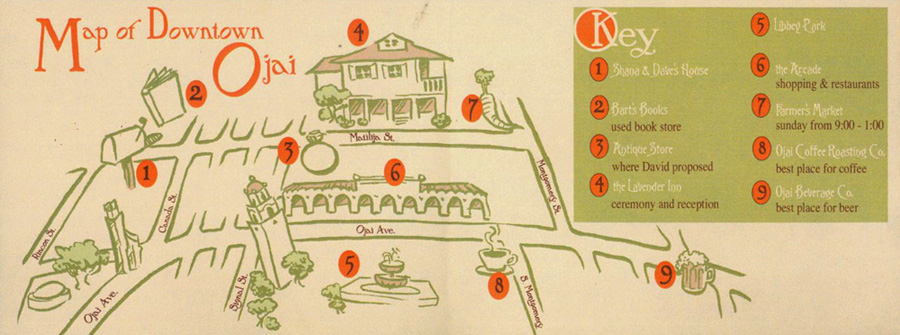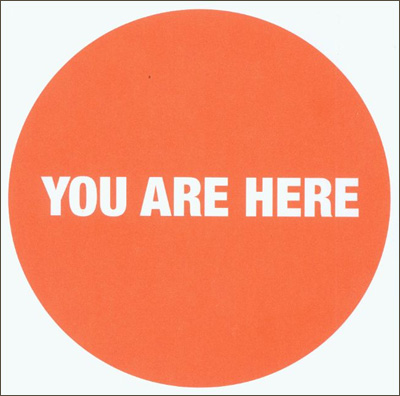Five Directions:
An Essay in Maps and Captions
1.
Better Judgment
My Aunt Billie has lived in the same house on Vallambrosa for the last forty years. In my lifetime, nearly all of my mother’s, we have never visited her anywhere else. Yet, as we prepare to leave, she still feels compelled to draw a map to get my mother and me to a gas station and then back on the freeway. We’ve told her about the new GPS, about the curt turn left and the irked recalculating. We’ve told her we’ll be fine, but she is firm. “Honey, you can’t trust that gremlin,” she says. And maybe we can’t. She signs the map.
2.
North Carolina
This postcard map of North Carolina, though detailed, is functionally close to useless. Scaled beyond any navigational utility, it is a statement of roadways, of development, of things that pass in and out. A place you are meant to recognize from other maps, I think, and not from your own afternoons in its graveyards. No, here it is just the idea of rivers linked to lakes, of paths that diverge and connect and stay where you left them. The reverse of this postcard is much the same, a note from a friend looking for jobs, apartments, wondering whether to really leave our shared Chicago to follow a man. There’s a sense of general direction in her writing, but it seems to fail her in the details, in the final turns that would take her home.
3.
Downtown Ojai
When the wedding invitation arrives, I almost forget the map. The wedding is in my hometown, after all, and the invitation from an old high school friend who lives close enough to my stray wedding guests that need a place to stay. Which is to say, I don’t need a map, I already know my way around town—the best bookshops and the farmers’ market, the inn where they’re getting married, all of it. But, it turns out, I do need this map, this beautiful thing drawn by my friend, this little chart that delayed the mailing even after the calligraphy was done and the stamps affixed because it was that important. And I begin to see why, the story of their life in one place, their home and their work and the proposal and the wedding just blocks apart. I look at this map and realize I cannot remember ever seeing a map of my hometown before, though surely there was one in the phonebook, a bus shelter, somewhere. Most of the city’s streets I know from back when the bride and I ran cross country together, the summers when I learned the names for the east end streets and the back routes and the side streets with her at my elbow, ponytails swinging, her breath in my ear as we followed the straight shots and the switchbacks and the dog legs that sent us out to the orchards, over the hills, around the fire station, down to the creek, up the canyon, and, at last, back where we started.
4.
You Are Here
You are here. Of course you are. And it’s comforting, even if it’s a lie, the very gap between you and the words you’re reading are distance enough to invalidate the statement. But we won’t quibble, not when you’ve been so kindly included, not when someone has anticipated that you should be looking to find your way and has made the effort to affirm, with great forethought, and authority, that wherever you may be heading, yes indeed, you are here. And what more could a map of exhibitions about maps tell you? What more could a whole city worth of maps say? And what more could you need to hear?
5.
When You're Pretty Sure You've Gone Too Far
June says it perfectly. My favorite part, indeed the part that gets me to the right place, is that you need to keep going, even when you’re pretty sure you’ve gone too far. This is exactly what I tell people who ask how to get to the orchard. I quote it in emails to would-be apple-pickers. It’s what I repeat from the back seat as Cutter and Erin steer us south ever farther out of town, their puggle, Max, darting across my lap to sniff from the left window and then the right and then back again as everything beyond the border of the car door changes.
June’s directions to the apple orchard, simple as they are, need updating the very next year. It’s not that Sand Road has changed. And the orchard is still there, though the heart-shaped honor box and the kitchen scale next to it are gone. The table they sat on, too. The letters have been pulled out of the marquee, the miraculous statement “10c/pound” vanished. The apples themselves are mostly gone, all rows picked clean save the last two. It begins to feel like trespassing. But the farmer, if you catch him walking the rows, will tell you to go on ahead. Pick what you like. Free. And do you need another bag to carry it all.
~
Figures:
1. Crosby, Billie. “Love You against My Better Judgement, Billie.” Hand-drawn map. Chico, CA, 2006.
2. Doane, Jim.
“North Carolina.” Postcard. Charlotte, NC: Aerial Photography Services, Inc. n.d. Print.
3. Manion, Shana K. “Map
of Downtown Ojai.” Map. Scale not given. Ojai, CA. 2009. Print.
4. “You Are Here.” 2007. Envelope for the "Festival of Maps." Chicago,
IL. 2007. Print.
5. Melby, June L. “Re: OMG.” Message to the author. 7 Oct. 2008. E-m





